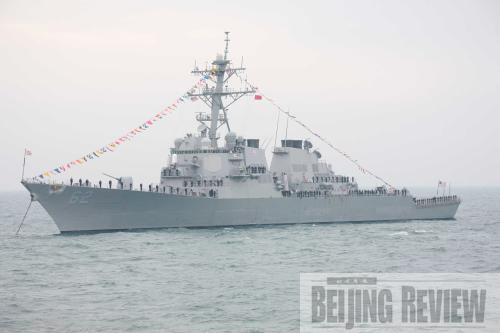|
 |
|
IN FULL GLORY: The USS Fitzgerald participates in the international fleet review in Qingdao on April 23 LI GANG |
Sino-U.S. military relations recently received another boost. The Japan-based U.S. destroyer USS Fitzgerald joined Chinese and foreign naval vessels in a grand international fleet review to celebrate the 60th anniversary of the founding of the Navy of the People's Liberation Army (PLA) in the coastal city of Qingdao, Shandong Province, on April 23. A total of 21 foreign ships from 14 countries took part in the event.
Military-to-military relations are important to the broader, comprehensive relationship between the United States and China, Admiral Gary Roughead, U.S. Chief of Naval Operations, said at a press conference in Beijing on April 19.
Roughead is the highest-ranking U.S. military officer to visit China since the beginning of this year. During his visit on April 17-20, he held discussions with Wu Shengli, Commander of the PLA Navy, on building a stronger relationship between the Chinese and U.S. navies. He also attended celebrations marking the 60th anniversary of the founding of the PLA Navy in Qingdao.
For example, the U.S. and Chinese navies are working together against the threat of piracy off the coast of Somalia. He believes the day-to-day operations there are a "tremendous confidence-building measure" for the two navies.
The PLA Navy sent two destroyers and a supply ship in December last year to the Gulf of Aden and the waters off the Somali coast to protect merchant vessels against rampant piracy in the region. In early April, it dispatched another two warships to the region to relieve the two destroyers after a three-month escort mission.
Roughead identified counter-piracy, humanitarian assistance and exchanges between young naval officers as major areas of cooperation between the U.S. and Chinese navies.
Jin Canrong, Deputy Dean of the School of International Studies at Renmin University, described the U.S. Navy's participation in the fleet review as something "very positive.
"It shows that the two countries' military relations are currently in good shape and is conducive to the future development of these relations," said Jin, a prominent scholar of China-U.S. relations, in an interview with Beijing Review.
China-U.S. military exchanges came to a standstill following the mid-air collision between a Chinese fighter jet and a U.S. surveillance plane in May 2001. They were restored during the second term of the Bush administration. In 2006, the Chinese and U.S. navies conducted a joint search and rescue exercise first in the waters off the coast of San Diego, California, and then in the South China Sea.
The growth of the PLA Navy is consistent with China's economic advancement and its role in a globalized world, Roughead said.
"As China has moved forward and as navies exist to ensure the freedom of the seas and the flow of commerce and communication on the seas, it's not surprising to me to see the PLA Navy develop in the way that it has," he said.
Since it was founded on April 23, 1949, the PLA Navy has developed into a modern maritime force with both nuclear and conventional means of operation, according to a national defense white paper the Chinese Government issued in January.
The Ministry of National Defense of China and the Department of Defense of the United States signed the Military Maritime Consultative Agreement in 1998, creating a forum for the two countries' navies to hold discussions.
"I think it's important that it not just be a venue where we talk about our problems, but I think it has to be a venue that would also talk about the opportunities and the positive things that we can do," Roughead said.
U.S. President Barack Obama has made a good start in China-U.S. relations since he took office in January, Jin said. The two countries now face opportunities to strengthen their military-to-military ties thanks to the congenial political atmosphere, he said.
Another positive trend is that as the PLA Navy becomes modernized, China and the United States will be able to conduct military dialogues on an equal footing, he noted. There is also great potential for them to cooperate on non-traditional security issues such as humanitarian assistance, counter-piracy and antiterrorism, he added. | 